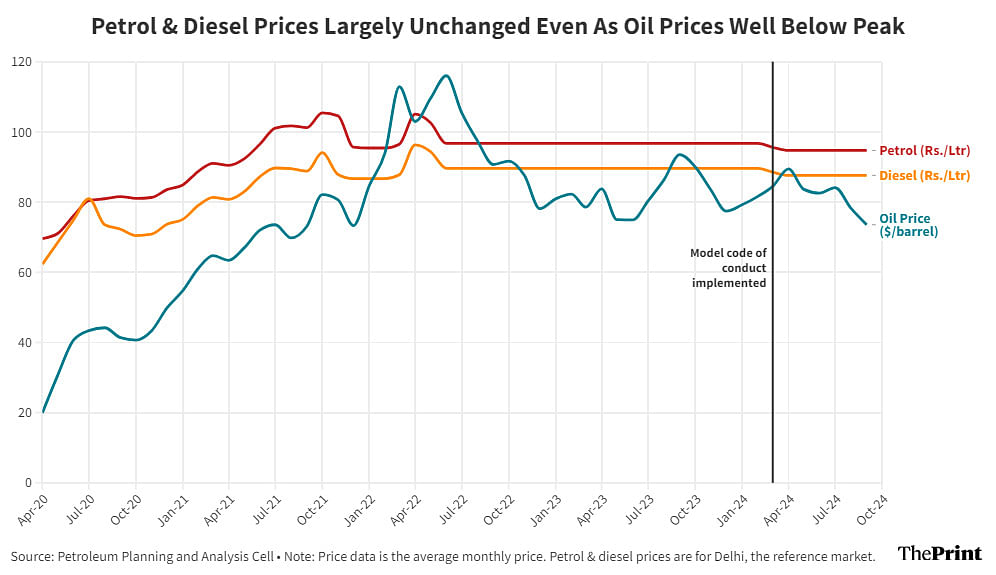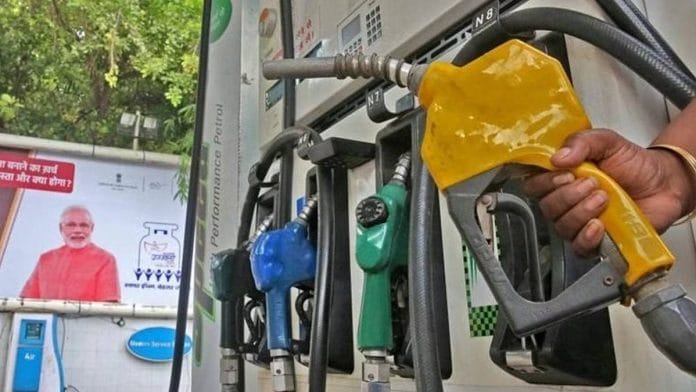The Narendra Modi government is using its overwhelming dominance in the fuel market not for strategic or financial reasons but for political opportunism, and this must stop immediately. It is no coincidence that fuel prices — which had remained unchanged since June 2022 — were lowered a day before the model code of conduct for the 2024 general elections took effect in March.
This election-related manipulation of fuel prices has been evident before. It would surprise nobody if fuel prices were reduced again shortly before the upcoming assembly elections. This is blatant misuse of public sector institutions for political gain and should be called out as such.
International oil prices fell below $70 a barrel last week and have hovered around that level since. Average oil prices for Indian purchasers stand at $73.5 — the lowest they have been since December 2021 — and are likely to fall further in line with the international trend. In theory, this should mean that fuel prices in India, which are supposed to be revised daily based on prevailing oil prices, should also have decreased, right? Wrong. They have barely changed since June 2022.
The government-run oil marketing companies (OMCs) — Indian Oil Corporation, Bharat Petroleum Corporation, and Hindustan Petroleum Corporation — control about 95 percent of the market. Of the three parties affected by fuel prices — consumers, the government, and the OMCs themselves — surely the public sector companies have kept the interests of the consumers at the forefront? Wrong again.
Since September 2022, the OMCs and the government have been the primary beneficiaries of high fuel prices, often at the expense of consumers.
But okay, since it is the OMCs that officially set fuel prices and not the government, one might assume that politics and elections have no impact on fuel price movements. Wrong for the third time. There’s a strong link between election dates and fuel prices.

Also read: How fuel prices become mysteriously stable just before elections. Here’s data since 2020
A pricing policy for whose benefit?
In June 2017, the government introduced a dynamic fuel pricing policy under which petrol and diesel prices were revised daily based on the prevailing price of oil. This market-linked, transparent mechanism worked well during the first term of the Modi government.
In the second term, however, distortions began to appear in this mechanism. An analysis by ThePrint in December 2022 found that OMCs increasingly kept fuel prices unchanged in the run-up to assembly elections, only to raise them soon after the elections were over.
In June 2022, the OMCs abandoned the dynamic pricing policy entirely and froze fuel prices. This freeze lasted nearly two years until March 2024, when they reduced fuel prices by Rs 2 per litre, and have kept them frozen since then.
Now, the thing is, freezing prices was a good idea given the turmoil in the oil market due to Russia’s invasion of Ukraine in January 2022. Oil prices shot up to $116 a barrel by June, and passing this increase on to Indian consumers would have hurt them tremendously.
When OMCs — which purchase and refine oil to sell fuel — keep fuel prices relatively low during periods of high oil prices, they naturally incur losses. As they bear these losses to protect consumers, it is fair to allow them to recoup these losses before returning to dynamic pricing. There is no dispute there.
The problem arises when they not only recoup their losses but also make huge profits — and pay large dividends to the government — yet still do not lower fuel prices to benefit consumers. Unless elections are approaching, of course.
Also read: How CNG prices have taken the gas out of Delhi’s auto drivers and their livelihoods
Govt’s hiding behind uncertainty
A more recent analysis by ThePrint found that the financial impact of absorbing high oil prices was short-lived. While state-run OMCs experienced two quarters of losses from April to September 2022, they quickly returned to profitability.
In fact, the three state-run OMCs ended FY 2022-23 with profits of Rs 19,086 crore, meaning that the profits earned in the last two quarters of that financial year exceeded the losses incurred in the first two quarters.
This strong profitability continued into FY 2023-24, with state-run OMCs seeing profits surge by a whopping 324 percent as oil prices remained significantly lower than when fuel prices were frozen.
This increase in profits allowed the OMCs to pay the government Rs 12,775 crore in dividends, an 83 percent increase over the previous year.
Despite this return to profitability, the OMCs decided to reduce petrol and diesel prices — by Rs 2 per litre each — only once, on 15 March 2024. The model code of conduct for general elections 2024 kicked in the next day.
Oil prices are currently nearly 40 percent lower than they were in June 2022, when fuel prices were effectively frozen, yet consumers have not benefited from this decrease.
When asked about this, the government has conveniently argued that fuel prices are set by the OMCs, not by the government. However, the OMCs direct all enquiries about fuel pricing to the petroleum ministry.
The state-run OMCs must answer several questions. First, who is actually responsible for setting fuel prices in India? Second, if the OMCs are responsible for setting fuel prices, why have they abandoned the official dynamic pricing policy for so long? Third, why do price changes so closely align with election dates?
If the government is indeed setting prices — which is by far the more likely scenario, despite official claims — then it should officially discard the daily pricing policy adopted in 2017. You can’t have an official policy stating one thing while actual practice demonstrates the opposite.
This shift in how fuel prices are determined in India has undone the transparency introduced earlier, moving to an opaque system that lacks credibility. Yet the government doesn’t seem to care about this regression. Don’t be surprised if the PM announces a ‘gift to the nation’ just days before the next assembly election.
TCA Sharad Raghavan is Deputy Editor – Economy at ThePrint. He tweets @SharadRaghavan. Views are personal.
(Edited by Prashant)






